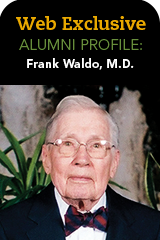The Science Behind the Safeguards
By Cary Estes
 |
Some of the worst disasters strike with invisible force. Pandemics and plagues have afflicted the world for centuries, with viral strains such as SARS, avian flu, and H1N1 raising alarms in recent years. Mankind has created chemical devastation as well, from the use of weaponized chlorine gas in World War I to current threats of chemical terrorist attacks.
In response, School of Medicine scientists are leading a variety of emergency preparedness research initiatives in the lab and in the field. They collaborate with colleagues in UAB’s School of Public Health and Birmingham’s Southern Research Institute on many projects—a team approach researchers say is crucial for long-term success against common challenges.
“We can bring together the knowledge of screening on one side with medicinal chemistry on the other to have an aligned front to help the biomedical community,” says Richard Whitley, M.D. (fellow ’77), director of Pediatric Infectious Diseases; the Loeb Eminent Scholar Chair in Pediatrics; and a leader of UAB’s Center for Emerging Infections and Emergency Preparedness (CEIEP).
Infection Protection
The CEIEP is an example of collaboration in action. In 2006, two centers—one focusing on emergency care and disaster preparedness and the other emphasizing biodefense and emerging infections—merged to form the current center. The goal, says Whitley, who co-directs the center with UAB emergency medicine physician Henry Wang, M.D., was to address the practical issues of emergency department logistics along with the theoretical issues of potential infectious disease outbreaks. The CEIEP’s mission now includes research, training, and education along with service opportunities in the areas of biodefense, emerging infections, emergency medical care, and public health disaster preparedness in Alabama and across the world.
Much of the center’s initial work focused on developing drugs to treat mammal-based orthopox viruses such as smallpox. After the terrorist attacks of September 11, 2001, the U.S. government identified the easily dispersed variola virus that causes smallpox as a possible bioterrorist weapon, leading to the vaccination of select first responders and military personnel. Work has progressed steadily on new antiviral therapies, and the center scientists are beginning animal studies, Whitley says.
In recent years, CEIEP researchers have expanded their work and have developed emergency response plans for smallpox and anthrax attacks as well as pandemic influenza outbreaks. These plans were put to the test in 2009 when the sudden emergence of H1N1, popularly known as swine flu, panicked the public and stretched the government’s ability to respond.
“I call 2009 H1N1 a dress rehearsal for the real deal,” says Whitley, who served on the 2009 H1N1 influenza working group of the President’s Council of Advisors on Science and Technology, which provided recommendations on federal flu response to President Barack Obama.
“We learned a lot of good lessons,” he says. “There should have been a better mechanism for collecting the data. Antiviral medicines should have been more readily available. But overall, the state of Alabama did a good job handling the issues created by a new, potentially lethal strain of flu—a better job than many places—because we were prepared.”
Protecting the Smallest Patients
UAB’s role in preparation for the 2009 flu season, which was dominated by fears of H1N1, led directly to a critical breakthrough. The most common vaccine used to fight H1N1 is oseltamivir, which is sold under the name Tamiflu. Whitley says that before last year, the U.S. Food and Drug Administration (FDA) had not approved Tamiflu for children younger than 2 years.
David Kimberlin, M.D., UAB professor of pediatric infectious diseases, had been leading a study evaluating the safety of Tamiflu for use in children aged 6 months and older. In June 2009, the FDA requested their data and used the information to grant emergency-use authorization of the drug for young children. The Centers for Disease Control and Prevention (CDC) and the World Health Organization (WHO) also made use of UAB’s data.
“Our goal now is to move the emergency-use authorization of oseltamivir to full licensure,” Whitley says. “We’ll be working with the National Institutes of Health (NIH), FDA, CDC, and WHO to get oseltamivir licensed for babies. We have to get the database to the point where it’s acceptable for a new drug application. That involves a lot of nitty-gritty work in terms of making sure data match up with the case records.”
Chlorine’s Collateral Damage
A similar breakthrough could be on the horizon for Sadis Matalon, Ph.D., the Alice McNeal, M.D., Endowed Chair in Anesthesiology, and his research team, who are examining the effects of chlorine gas on the lungs. In 2008, UAB received a $3.4-million, three-year NIH grant to establish a Research Center of Excellence in conjunction with Yale University and Southern Research Institute. UAB already is a member of the NIH-sponsored CounterACT Research Network, which aims to find treatments for toxic chemical exposure.
More than 25 million tons of chlorine are manufactured each year in the United States, and the gas is most often shipped by rail. Derailments and industrial explosions can expose people in the immediate vicinity to potentially lethal levels of fumes, and in 2006, authorities evacuated more than 17,000 residents of Apex, North Carolina, after an explosion at a local plant.
Soldiers and civilians in combat areas are also at risk; Iraqi insurgents have used chlorine gas in truck bombs targeting civilians and military personnel. Matalon says one of his team’s key discoveries is that chlorine exposure can create damage in both healthy people and those with existing lung conditions that lasts long after people begin to recover from initial exposure.
“The idea is to develop antidotes,” Matalon says. “People get sick, and then they feel better, but we have found that they don’t really get better. They develop reactive airway disease syndrome, and the damage is worse 24 hours after exposure than it is after one hour. And it remains for at least six days. During this time people feel better, but their airwaves are supersensitive. This is a prelude to developing asthma.”
Current research focuses on the physiological underpinnings of the syndrome, which will provide critical clues to its treatment. The solution might be as simple as an aerosol blast of ascorbic acid, better known as vitamin C. Matalon explains that vitamin C is a natural substance found inside the lungs, and his research has found that it’s capable of detoxifying the free radicals in chlorine that destroy lung tissue. In theory, he says, a dose of vitamin C administered directly into the lungs could work as a treatment for otherwise fatal chlorine exposure.
Aerosolized vitamin C would serve as a “reinforcement” to the lungs’ natural supply of the vitamin, Matalon says. “The antioxidants would be the first line of defense, detoxifying chlorine and preventing it from hitting important targets in the lungs. It is our hope to save lives and help people preserve and recover as much lung function as possible.” His research has advanced successfully through the preclinical stage and trials for patients are set to begin this year.
Matalon and Whitley realize that research can’t anticipate every problem created by bioterrorist threats, but each breakthrough is another step toward minimizing the impact of future disasters. “We’re constantly learning lessons about how to do things better the next time around,” Whitley says.
